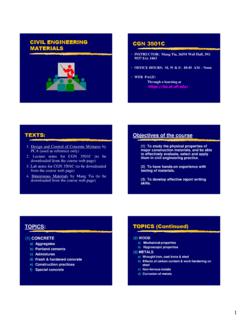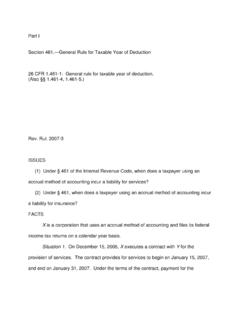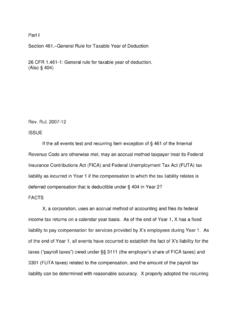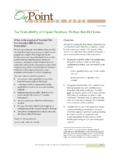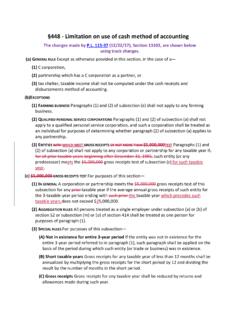Transcription of Capitalization , Amortization, and Depreciation
1 Capitalization , amortization , and Depreciation Introduction In general , expenses are deductible if allowed by a specific code section . Capital expenditures, in contrast, are not deductible; instead, they must be added to the basis of an asset. From there, they may or may not result in future Depreciation or amortization , depending on the type of asset. For example, the cost of land must be capitalized and is never subject to Depreciation or amortization recovery. In contrast, five years worth of pre-paid insurance must also be capitalized; however, it may then be amortized over the five-year life. These very simple rules are subject to some controversy and require much refinement. The difference between an expense and a capital expenditure is sometimes obvious. For example, the replacement cost of a single shingle blown off a roof by a hurricane is clearly an expense and thus not subject to Capitalization - for two reasons.
2 First it is minor and thus not worth the process of Capitalization and Depreciation . Even though the shingle itself may actually last many years, depending on the remaining life of the roof, the minor cost is not worth the accounting trouble. Second, its replacement does little to change or extend the life of the main asset the roof. Hence it is just a short-term, minor repair and gives rise to the allowance of a deduction under section 162 as an ordinary and necessary business expense (assuming, of course, the roof was on a building used for a trade or business). For accounting purposes, we would debit an expense account repairs and credit a payable or cash account to reflect the payment or the creation of a liability. At the other extreme, an entire new roof will last some twenty years and its costs must surely be spread over that time frame. The process of doing so is called Capitalization of the expenditure and Depreciation of the asset.
3 Technically, for accounting purposes, we would debit an asset account for the cost and credit either a payable or cash account to reflect the payment or creation of a liability. The asset account may be a separate asset - called new roof or it may result in an adjustment to the basis of the building. As illustrated below, however, many fact patterns do not so clearly involve a simple repair or an obviously new long-term asset. They can be very close to the line delineating repairs versus capital improvements. As we will see, that line can be both fuzzy and a moving target. Courts have mostly resolved it using a facts and circumstances method of analysis. Other issues of Capitalization involve the various accounting methods. As a general rule cash method taxpayers may deduct expenses when paid. As a general rule, accrual method taxpayers may deduct expenses at the later of incurrence under the all events test and economic performance pursuant to section 461(h).
4 Each of these general rules, however, is subject to regulations under section 461 and 263 plus several important appellate decisions. Some of these authorities have been, at least historically, controversial. An additional issue involves what to do with the allowed Depreciation or amortization expense that follows initial Capitalization . Typically, it is deductible. In some instance, however, it must itself be capitalized into the basis of another asset; or, it may be subject to one of many limitation provisions such as those limiting deductions due to passive activities or activities for which the taxpayer is not at risk. Overview This chapter first covers the historic rules involving cash accrual treatment of intangible assets. Although these historic rules have largely been replaced with new statutes and regulations, knowledge of the historic treatment is instructive in understanding current rules.
5 Second, the chapter covers the controversy regarding the difference between a repair and a capital expenditure. Promised new regulations may soon provide new guidance on this issue. Third, the chapter covers the Idaho Power decision an important deviation from provisions which otherwise permit current deductions. This case is essentially the father of current section 263A and the uniform Capitalization rules. Fourth, the chapter covers the recent historical (and arguably continuing) controversy regarding the Supreme Court's decisions in Lincoln Savings and INDOPCO. Essentially, Lincoln Savings focused on the existence of a separate and distinct asset as an important indicator of the need for Capitalization . INDOPCO arguably a huge government victory . focused instead on the future benefit of various expenditures, irrespective of whether they created a distinct asset. In partial resolution of this issue, the Treasury issued new regulations in 2004 under section 263, tending to favor the distinct asset analysis.
6 Again, an understanding of the history of the rule will elucidate the new (and controversial) regulations. Fifth, the chapter examines some large exceptions to Capitalization . These include such sections as 173 (circulation expenses), and 175 (soil and water conservation costs). Each involves items that would be capital under the normal rules. Congress, however, permits early deduction. Also covered are important exceptions permitted by rulings and regulations. Sixth, the chapter covers other important expense deferral rules which have the effect of Capitalization . These include sections 404 (dealing with non-qualified deferred compensation), 461(h) (economic performance), 465 (at risk), 469 (passive activity rules), and 163(e). (investment interest limitations). Full coverage is not included in this chapter; however, an overview is instructive in understanding Capitalization as cost recovery deferral.
7 Seventh, the chapter covers amortization of intangibles, with specific emphasis on sections 195, 197, 174(b) and 467. Lastly, the chapter covers Depreciation of tangible property. section 1 Historic Capitalization Rules Governing Intangible Assets Historic Cash Method Rules Reg. Generally expenses are deductible under the cash method when paid. However, if the payment of the item creates an asset with a life that extends "substantially" beyond the close of the year, the amount must be capitalized and then amortized over the period to which it is applicable. At least that has long been the rule under Treasury Regulation (a)(1).1 As 1. If an expenditure results in the creation of an asset having a useful life which extends substantially beyond the close of the taxable year, such an expenditure may not be deductible, or may be deductible only in part, for the taxable year in which made.
8 Reg. (a)(1). discussed below, Treasury Regulation (a)-4(f),2 promulgated in January, 2004, casts serious doubt on the continued validity of the prior rule. The historic critical issue was the meaning of the word "substantial." A clear implication of the section 461 regulation is that a pre-payment that extends for an "insubstantial" period beyond the end of the payment year is deductible when paid. Although the "substantial" test now appears clearly in the regulations, it has not always been there. Prior to 1942, some pre-paid expenses were deductible when paid. The First Circuit discarded those authorities in 1942 in the important Boyston Market3 decision, discussed in Chapter _____. Boylston Market, while historically important, told us little about the meaning of the word "substantial." This is true because the pre-payment period extended at least two full years beyond the year of payment.
9 That length of time would constitute a substantial period under almost any view. Three more recent decisions provided clearer guidance about the meaning of the term substantial. They also illustrated a clear split of authority between the Tax Court and the Ninth Circuit. The Ninth Circuit view used a rule of easy application in the historically important Zaninovich4 decision. The word "substantial" meant approximately one year. Thus if a taxpayer paid an expense and thereby created an asset with a life extending less than one year beyond the end of the year of payment, the entire expense would be deductible when paid and no portion need have been capitalized. If, in contrast, a taxpayer paid for a period extending more than one year beyond the end of the payment year, the entire amount must have been capitalized and then amortized pursuant to Boylston Market. Naturally, in such an event, the portion attributable to the year of payment would be deductible in that year.
10 The entire remaining portion - including that attributable to the following year - must have been deferred till later. Despite the apparent arbitrariness of the one-year rule, the Ninth Circuit noted in footnote six of Zaninovich that it was only a "guidepost" in cases involving a payment extending more than one year beyond the end of the payment year. A 1981 decision of the Ninth Circuit illustrated that "mere guidepost" proposition. The case - Commissioner v. Van Raden5 - involved the December 1972 purchase of a one-year supply of feed corn and silage for $360,400. While the cattle consumed none of the feed during that year, they consumed 98 percent of the corn and 91 percent of the silage during 1973. This represented 98 percent of the cost. The court sided with the taxpayer, finding that the leftover two percent - at the end of 1973 - did not amount to an expense which extended substantially beyond the end of 1972: We do not believe there is any legitimate basis for distinguishing feed payments from rental payments for the purposes of the "one-year rule.
